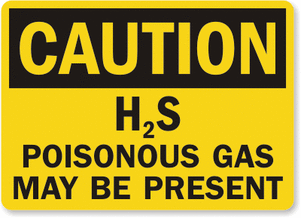| Pushing the Limits | Hydrogen Sulfide Facts |
What is Hydrogen Sulfide (H2S)?
Hydrogen sulfide (also known as H2S) is a colorless, highly toxic, and extremely flammable gas. Even at low concentration levels, H2S is dangerous. Workers exposed to hydrogen sulfide can face a variety of health impacts, ranging from mild to serious, including death.
Hydrogen sulfide is known for having a rotten egg odor at low concentrations, and is commonly called sour gas, sewer gas, swamp gas, stink damp or rotten egg gas. But, with continuous H2S exposure or high concentration of the gas, exposed workers lose their sense of smell. So workers cannot rely on an odor to warn them of the gas’s presence!

Where is hydrogen sulfide found?
H2S can occur naturally in places such as oil and gas wells, sewers, well water and manure pits. H2S is also used or produced in a variety of industries, such as ‘Sewer and Wastewater Treatment’, ‘Oil and Gas Refining’, and ‘Textile Manufacturing’.
Certain industries and workplaces have increased reports of toxic gas, however pockets of H2S gas can occur anywhere. Because hydrogen sulfide is heavier than air, it can collect in low-lying or enclosed spaces. Confined spaces such as pits, manholes, tunnels, and wells, can be particularly dangerous, since hydrogen sulfide can build up to dangerous levels in these areas.
What are the health hazards of hydrogen sulfide exposure?
Workers are primarily exposed to hydrogen sulfide through inhalation, where the gas is then rapidly absorbed by the lungs. Depending on the gas concentration levels and the length of exposure, the health effects can range from ‘mild and short-term’ to ‘serious and long-term’. Some of the many possible effects include headaches, eye irritation, airway problems, coughing, staggering, unconsciousness or death. Workers who are unprepared for H2S exposure can quickly be overcome by the gas. At high H2S concentrations, serious health effects can begin after a single breath!
How can workers be protected from hydrogen sulfide exposure?
Before entering spaces where hydrogen sulfide may be present:
- A qualified person must test the air with proper equipment for the presence and concentration of hydrogen sulfide. Fire and explosion precautions should also be taken.
- If H2S gas is present, the area must be ventilated continually to remove the gas.
- If the gas can’t be removed, a worker entering the area must use the appropriate respiratory protection, additional PPE, as well as rescue and communication equipment.
It’s important to have controls in place that will either keep H2S concentrations at safe levels or isolate the gas entirely. Work practices such as using the buddy system, preventing sparks, working upwind of H2S sources, and following Contingency Plan precautions can also help keep workers safe. Workers should also be familiar with proper emergency response if a co-worker has suffered H2S poisoning.
Who needs Hydrogen Sulfide Awareness training?
Hydrogen Sulfide Awareness training should be taken by ALL workers who could potentially be exposed to hydrogen sulfide on-the-job. Those who work in industries or workplaces where H2S gas is more frequently reported, such as in wastewater treatment, natural gas and the petroleum industry, must be properly trained. In addition to H2S training, workers may need additional Personal Protective Equipment training and Confined Spaces training.
Where can I get H2S Awareness Training?
HazMat Student’s 100% Online Hydrogen Sulfide Awareness course was designed to comply with OSHA 29 CFR 1910 and 1926, ANSI Z390.1 Accepted Practices for Hydrogen Sulfide (H2S) Training Programs. The training includes training topics such as:
- What is Hydrogen Sulfide? Where is it used and found?
- Symptoms and Effects of Exposure
- Protecting Yourself from Exposure
- H2S Detection and Monitoring
- Contingency Plan
- Emergency Response
With the proper training, workers can be aware of the dangers of H2S and learn about safe work practices in areas where hydrogen sulfide may be present.



